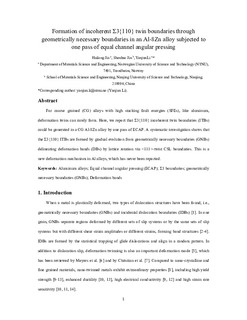| dc.contributor.author | Jia, Hailong | |
| dc.contributor.author | Jin, Shenbao | |
| dc.contributor.author | Li, Yanjun | |
| dc.date.accessioned | 2018-09-14T07:50:11Z | |
| dc.date.available | 2018-09-14T07:50:11Z | |
| dc.date.created | 2018-06-17T20:01:04Z | |
| dc.date.issued | 2018 | |
| dc.identifier.citation | Journal of Alloys and Compounds. 2018, 762 190-195. | nb_NO |
| dc.identifier.issn | 0925-8388 | |
| dc.identifier.uri | http://hdl.handle.net/11250/2562597 | |
| dc.description.abstract | For coarse grained (CG) alloys with high stacking fault energies (SFEs), like aluminum, deformation twins can rarely form. Here, we report that Σ3{110} incoherent twin boundaries (ITBs) could be generated in a CG Al-8Zn alloy by one pass of ECAP. A systematic investigation shows that the Σ3{110} ITBs are formed by gradual evolution from geometrically necessary boundaries (GNBs) delineating deformation bands (DBs) by lattice rotation via <111>-twist CSL boundaries. This is a new deformation mechanism in Al alloys, which has never been reported. | nb_NO |
| dc.language.iso | eng | nb_NO |
| dc.publisher | Elsevier | nb_NO |
| dc.title | Formation of Σ3{110} incoherent twin boundaries through geometrically necessary boundaries in an Al-8Zn alloy subjected to one pass of equal channel angular pressing | nb_NO |
| dc.type | Journal article | nb_NO |
| dc.description.version | submittedVersion | nb_NO |
| dc.source.pagenumber | 190-195 | nb_NO |
| dc.source.volume | 762 | nb_NO |
| dc.source.journal | Journal of Alloys and Compounds | nb_NO |
| dc.identifier.doi | https://doi.org/10.1016/j.jallcom.2018.05.168 | |
| dc.identifier.cristin | 1591739 | |
| dc.description.localcode | This is a submitted manuscript of an article published by Elsevier Ltd in Journal of Alloys and Compounds, 16 May 2018 | nb_NO |
| cristin.unitcode | 194,66,35,0 | |
| cristin.unitname | Institutt for materialteknologi | |
| cristin.ispublished | true | |
| cristin.fulltext | preprint | |
| cristin.qualitycode | 1 | |
